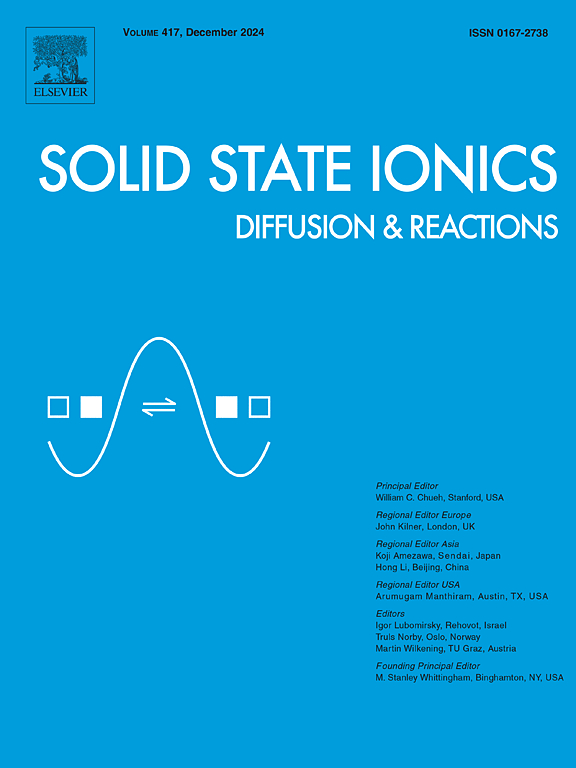Exploring the reaction process and properties of γ-Ce2S3 derived from pure and Na-doped CeO2 sulfurization with CS2
IF 3.3
4区 材料科学
Q3 CHEMISTRY, PHYSICAL
引用次数: 0
Abstract
The sulfurization pathways of pure and Na-doped CeO2 with CS₂ were investigated to elucidate the mechanism by which Na+ doping lowers γ-Ce2S3 synthesis temperature. For undoped CeO2, the synthesis of γ-Ce2S3 typically encompasses three primary steps: (1) deoxidation, where oxygen in CeO2 is substituted by sulfur to form CeS2; (2) reduction of CeS2 to α-Ce2S3; (3) a phase transition sequence from α-Ce2S3 to β-Ce2S3, and subsequently to γ-Ce2S3. This process requires a high synthesis temperature of up to 1300 °C. Remarkably, Na+ introduction fundamentally altered this pathway, bypassing α and β intermediates to directly yield pure γ-Ce2S3 at 900 °C. This is attributed to Na+-promoted formation of NaCeS2 and Ce2O2S intermediates that facilitate direct γ-phase crystallization. The resultant γ-[Na]-Ce2S3 solid solution exhibits modified band structure and enhanced thermal stability compared to undoped γ-Ce2S3.
探讨了纯CeO2和na掺杂CeO2与CS2硫化所得γ-Ce2S3的反应过程和性质
研究了纯CeO2和Na掺杂CeO2与CS₂的硫化途径,阐明了Na+掺杂降低γ-Ce2S3合成温度的机理。对于未掺杂的CeO2, γ-Ce2S3的合成通常包括三个主要步骤:(1)脱氧,其中CeO2中的氧被硫取代形成CeS2;(2) CeS2还原为α-Ce2S3;(3) α-Ce2S3→β-Ce2S3→γ-Ce2S3的相变序列。该工艺需要高达1300°C的高合成温度。值得注意的是,Na+的引入从根本上改变了这一途径,绕过α和β中间体,在900°C下直接生成纯γ-Ce2S3。这是由于Na+促进了NaCeS2和Ce2O2S中间体的形成,促进了γ相的直接结晶。与未掺杂的γ-[Na]- ce2s3相比,得到的γ-[Na]- ce2s3固溶体具有改变的能带结构和增强的热稳定性。
本文章由计算机程序翻译,如有差异,请以英文原文为准。
求助全文
约1分钟内获得全文
求助全文
来源期刊

Solid State Ionics
物理-物理:凝聚态物理
CiteScore
6.10
自引率
3.10%
发文量
152
审稿时长
58 days
期刊介绍:
This interdisciplinary journal is devoted to the physics, chemistry and materials science of diffusion, mass transport, and reactivity of solids. The major part of each issue is devoted to articles on:
(i) physics and chemistry of defects in solids;
(ii) reactions in and on solids, e.g. intercalation, corrosion, oxidation, sintering;
(iii) ion transport measurements, mechanisms and theory;
(iv) solid state electrochemistry;
(v) ionically-electronically mixed conducting solids.
Related technological applications are also included, provided their characteristics are interpreted in terms of the basic solid state properties.
Review papers and relevant symposium proceedings are welcome.
 求助内容:
求助内容: 应助结果提醒方式:
应助结果提醒方式:


